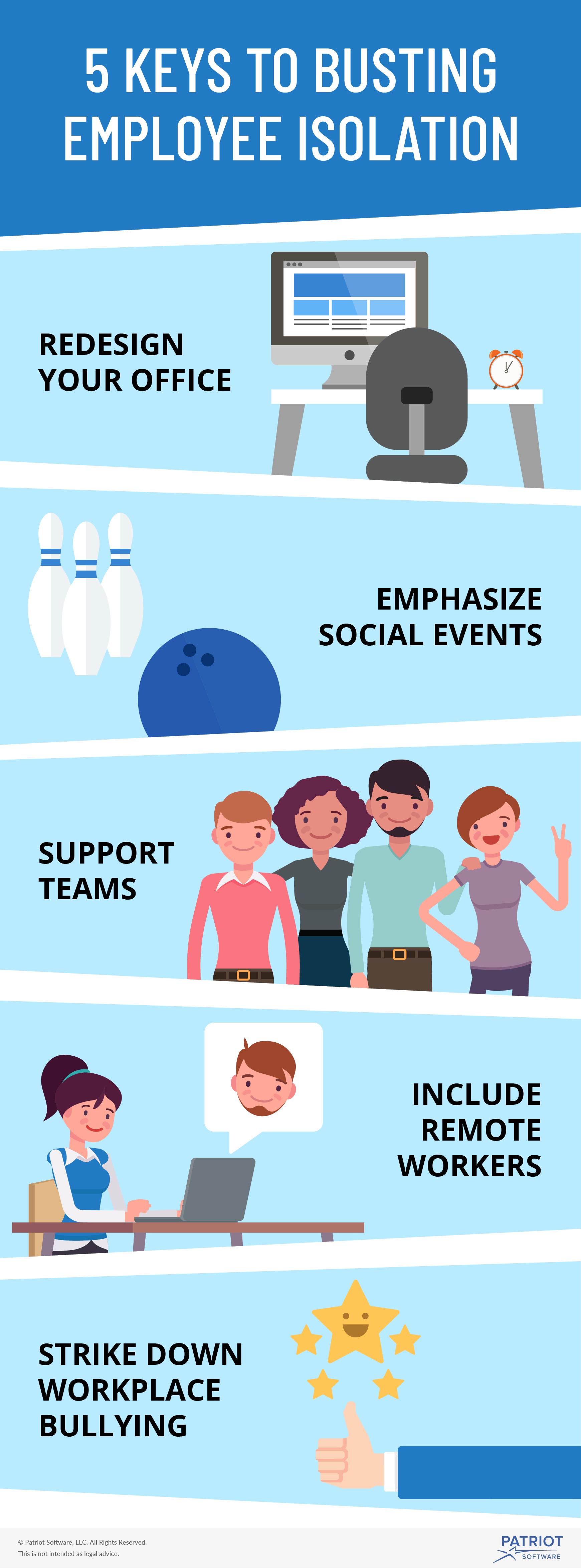Nearly half of American adults report feeling alone or left out, according to a recent study by Cigna. And, those feelings often crop up in the workplace. Even for employees who love their jobs, loneliness can result from an individualized workplace culture or a lack of communication.
As flexible work arrangements and freelance or contract work opportunities increase, there’s a higher chance employees won’t be coming into the office at all.
While working on an individual level often isn’t a bad thing, isolation and loneliness can lead to lower morale for employees, which can hurt retention rates since dissatisfied employees won’t be willing to stay at your company.
“There is an inherent link between loneliness and the workplace, with employers in a unique position to be a critical part of the solution,” said Dr. Douglas Nemecek, Chief Medical Officer for Behavioral Health at Cigna.
Employers can have a tangible impact on workers’ feelings of loneliness and isolation, even if the work your employees do doesn’t necessarily lend itself well to collaboration. Here are five steps you can take to fight isolation and make it more likely employees will stick around.

Redesign your office
Cubicle walls might be good for helping workers focus, but they can also hinder social interaction. If your office design has people facing away from each other or physically isolated, consider redesigning the layout to promote collaboration.
This might mean tearing down cubicle walls to build an open office layout, but it can also mean creating open spaces where employees can take breaks and chat. If you already have a break room or kitchen, encourage workers to use it. You could host casual get-togethers or meetings to make people more comfortable.
Creating more open areas for communication and collaboration can improve workers’ social skills and help them feel less lonely at work. In addition, it shows you’re willing to let employees take breaks as needed, which is a sign of trust that makes your work environment more enjoyable for everyone.
The Cigna study found only 53% of Americans have meaningful in-person social interactions daily. These interactions can significantly boost peoples’ moods and promote connections, which can make them feel more invested in the company. Think about opening up your office and creating spaces for more in-depth interactions.
Emphasize social events
Coworkers often spend more time together than families, so it’s important for them to develop positive relationships both at work and outside of it.
Offer workers opportunities to get out of the office and bond with coworkers. Some examples include creating a company-wide sports team, hosting a monthly or weekly happy hour after work, having cultural celebrations, or volunteering for charity work.
Getting the chance to spend time in a more relaxed environment without the pressures of work can bring lonely workers out of their shells and get them engaged. Avoid forcing the issue if someone’s not interested, but be sure to let more introverted workers know they’re welcome.
You may even want to talk to them and see what kinds of activities they may like better, like a movie screening or bowling night where they’re less likely to feel out of place.
Also, consider hosting events that are family-friendly and open to the public. For employees with kids, that eliminates the need for child care. And, other workers can bring a person they know to help break the ice.
Another example is starting a fitness program to help workers get in shape and do something healthy with coworkers. Whether it’s a weekly yoga class or just daily walks around the building, offer the chance for employees to get away from their desks and talk to others.
Plus, studies have shown people who say they get the right amount of exercise are significantly less likely to be lonely. In addition to helping workers beat loneliness, this can also lower your company’s healthcare costs.
These activities can also improve employees’ work-life balance by creating a happy medium between their jobs and their families.
Support teams
If your employees work in teams, encourage them to take breaks as a team. That way, they have the chance to interact and focus on something that’s not necessarily work-related, allowing them to bond further. And if they don’t work in teams, consider creating some or dividing things up by department instead.
Avoid making employees feel like they can’t talk about their personal lives while at work. Instead, ask questions that make them feel like you’re interested in them as a person, not just as an employee. For example, bring up someone’s weekend plans or family vacation.
As long as their work is getting done and these conversations aren’t becoming distracting, it shouldn’t be a problem. And, it’s these kinds of connections that decrease turnover.
You can also promote team-building exercises in meetings or other group settings, but avoid forcing employees into these situations. Some workers may be introverts who aren’t comfortable in big groups, and that’s OK. For these employees, provide opportunities for small group interactions or one-on-one conversations that can help them feel connected without forcing them into an activity they’ll hate.
Include remote workers
There are many potential isolation issues when you hire remote workers.
But remember, just because someone’s not in the office doesn’t mean they can’t participate in group activities. Encourage remote workers to develop routines around their work activities. This makes it easier for them to communicate with others in the office and helps them feel engaged and connected to others.
Instead of relying on conference calls and emails, use technology at your disposal and consider video chats for meetings so remote workers can see everyone’s faces and connect with their coworkers.
And, be sure to include them in any programs or events, such as a fitness and wellbeing programs. Even if they’re unable to make it, the invitation goes a long way to helping each person feel like they’re part of the team.
Strike down workplace bullying
Hopefully, there aren’t any bullies at your workplace. But, you can never be too careful. Ostracization and isolation are major strategies bullies use to intimidate coworkers. People are less willing to report these occurrences since they’re not physically being harmed, but the emotional damage can be just as severe.
A 2014 study revealed that feelings of exclusion are more likely to lead to job dissatisfaction, quitting, and health problems than other forms of bullying.
So how can you cut down on workplace bullying and reduce the likelihood that it’ll cause employee turnover?
First, focus on creating a culture of positivity and honesty. Let workers know they can trust you to listen and be sensitive when they tell you about personal issues they’re facing, so they know they can come to you if they’re being excluded.
If you’re hearing complaints about specific people, talk to them about what’s going on. They could be lashing out because of something else in their lives or not realizing how their actions are affecting others.
And if that doesn’t work, make sure you have a progressive discipline plan in place that can keep them on track.
Final thoughts
Whether employees are feeling isolated because of personal difficulties, work stresses, or office bullies, there are ways to help them connect with their co-workers and the rest of the workplace.
Some of those are as simple as hosting a few more social events, and some are more complicated, involving an overhaul of the office’s design. But any of them can help workers collaborate and come together, which benefits both their work performance and their mental health.
Making the effort to fight loneliness can help you retain your top talent–and attract other top talent who are impressed by your positive culture.
These views are made solely by the author.
